Semester7
Notes of courses done/attended in semester 7 in college
Lecture 2
Video
link
Agenda
- Internet Design Philosophy
Background
- Why do we need networking
- Telephone network vs Internet
- difference is usage
- telephone is for audio communication
- internet has many purposes, text, audio/video commu.
- Why packet switching was considered for the Internet Architecture
Today’s Internet
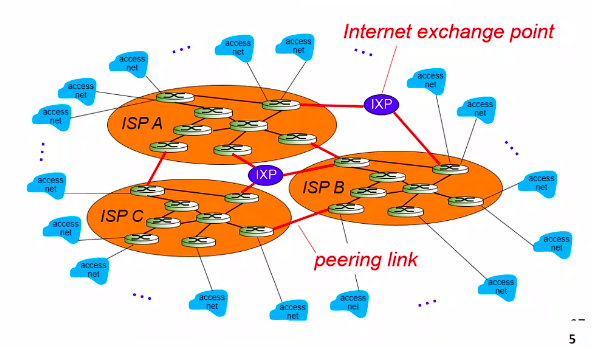
- There are diff ISPs
- Some are globally available ISPs
- how these connect?
- All ISPs need not connect to each other
- Whether one will connect to another or not depends on mutual agreement between them
- Large ISPs - Tier 1 ISPs
- then there are Tier2, Tier3
- this tier classification is according to the area they cover
- End user approaches to a distributor of an ISP for connection
- He provides me IP address and I connect
- The picture was not like this from beginning
Goals for Internet Architecture when it was designed
- Connect Existing networks
- Initially ARPANET and ARPA packet radio network
- Survivability
- if an intermediate node fails, connectivity must not be lost
- Support for multiple types of services
- differ in speed, latency, and reliability
- Ethernet is one tech, then satellite networks, then wireless, etc
- Must accodomate a variety of networks
- Allow distributed management
- Allow host attachment with a low level of effort
- Be cost affective
- Allow resource accountability
- Priority decreases as we go down
Connecting Networks
- ARPANET, x.25 networks, LANs, satelliute networks, packet networks, serial links..
- Many differences between networks
- Address formats, performance - bandwidth/latency , packet size, loss rate/pattern/ handling and routing
- Challenge
Survivability

- Ensure communication service even in the presence of network and router failures
- If both entities are ok and want to communicate, they should be able to, no other thing should be able to stop them
- If communication fails, I should store the state of communication to be able to restart
- Where to store?
- within network?
- in intermediate devices
- nah, what if they lose it
- at end points only
- until end points are up, I will be able to communicate
- FATE SHARING PRINCIPLE
- A failure where the nodes which want to communicate get divided into 2 halves, one with first node, and other with second node, if does not happen
- if they fail, I will anyway be not able to communicate
Fate Sharing
- Lose state info for an entity iff the entity itself is lost
- Why this?
- easy to debug problems
- appln developer will know ki prob client ya server side pe hai, not in intermediary devices
- Examples
- OK to lose TCP state if one endpoint crashes
- Putting firewalls and proxies is against internet design
- if both parties are up, still they might not be able to communicate if such devices are there
- Survivability compromise
- weak provisions for getting n/w failure information
Types of service : speed, latency, reliablity
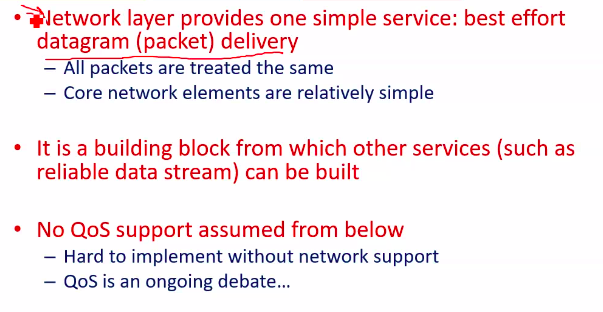
Two types of service
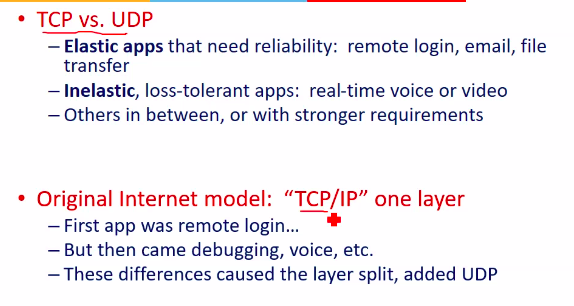
Standardization: Support Multiple types of networks
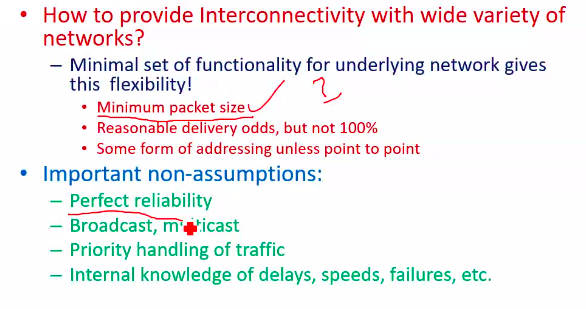
IP Hourglass
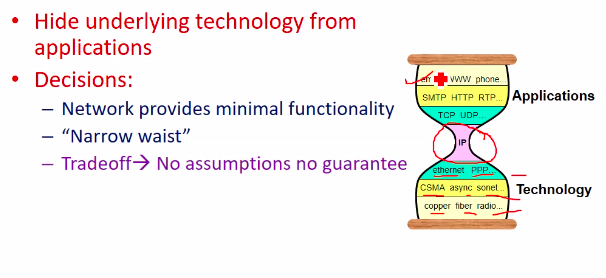
Next Class

Paper and Slides






